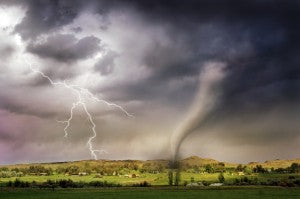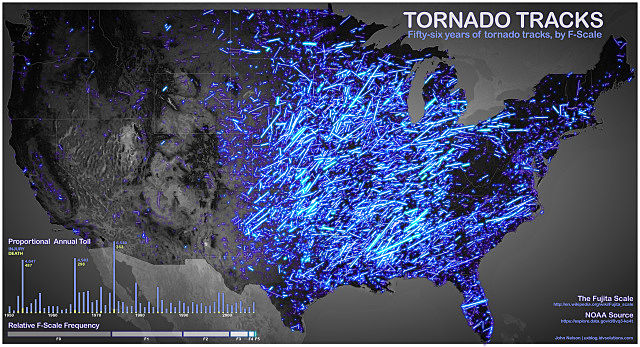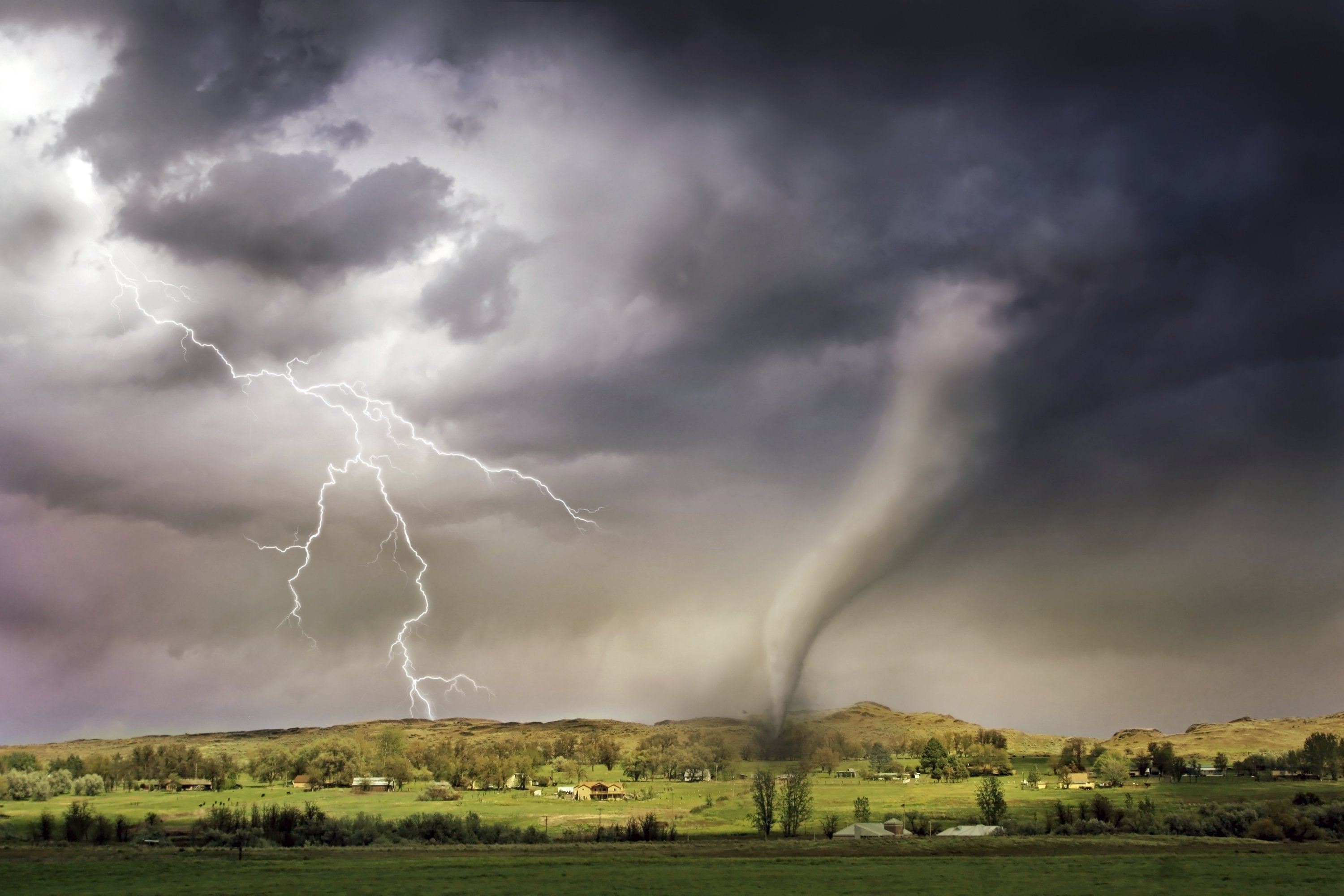

The National Weather Service (NWS) Storm Prediction Center (SPC) routinely collects reports of severe weather and compiles them with a Graphic Information System (GIS). This file contains track information regarding known tornados during the period 1950 to 2006.
According to an Associated Press report, a handful of tornadoes touched down in Northern California in March 2014. This area of the country, typically known for earthquakes and wildfires, experienced a tornado that damaged 20 homes. Many residents were not prepared for tornadoes, but they learned to prepare for the unexpected. This incident is important to keep in mind when preparing your own emergency supplies or when preparing to travel. Collect food, light, water, first aid, and communication supplies now so you can be ready if a storm hits. Myth #2: Tornadoes are unpredictable and therefore there is no way to prepare for them. Tornadoes do move unpredictably, but that doesn’t mean there’s no way to prepare. Meteorologists and networks like the NOAA or Weather.com use radars and satellites to monitor temperature and wind patterns, and can give frequent updates for your area and early warnings to help you get to safety in time. The Voyager Pro Radio also has a weather alert feature that automatically notifies you when there are severe weather alert warnings in your area. You can also become aware of the warning signs of an approaching tornado:- green sky
- hail
- heavy rain followed by an eerie calm or drastic wind shift
- churning debris
- the sound of continuous thundering
And now here's a video where you can actually see where they were...
Watching the first video is scary enough, but once I saw the aftermath of where they survived...it's incredible. And terrifying. Absolutely terrifying to think how close that tornado came to them. Now, if you’re driving when a tornado hits, get out of the car and lie flat in the nearest ditch (away from other cars and trees) or go to the closest building you can Replace to take shelter. Basements are also safe places to shelter in, but make sure there aren’t heavy appliances on the floor above you. Once you’re in the basement, get under a makeshift shelter like a workbench or mattress for added protection. Myth #4: I can outrun a tornado in my car. This may be true for trained meteorologists, so there is some debate over the issue. Tornadoes can shift quickly, and can move at about 70 miles per hour, so if there is no traffic and a straight road out of town, you may opt to take it instead of abandoning your car. If you decide it’s best to abandon your vehicle, be sure to leave it somewhere it won’t block emergency vehicles. Then Replace low ground—possibly a ditch. If there are flash flood possibilities, avoid overpasses; they can turn into wind funnels. Myth #5: If a tornado is heading your way, you should open all your windows. People have sometimes thought this equalizes pressure, but it really just causes you to spend your time on something other than getting to safety. Because of flying debris and wind velocity, there is no real way to protect your property, so your physical safety should be the first priority. Ultimately, Replaceing the right shelter, having the right tools, and making a plan beforehand will be the best way to prepare for the unpredictable. For more information on how to protect yourself during a tornado, check out our article, "Preparing for a Tornado." What are your tips for staying safe during a tornado? Sources: http://www.popularmechanics.com/outdoors/survival/tips/5-myths-about-tornado-safety-16793545?click=pm_latest http://www.ncdc.noaa.gov/oa/climate/severeweather/tornadosafety.html http://www.accuweather.com/en/weather-news/five-tornado-safety-myths/25676569 http://www.spc.noaa.gov/faq/tornado/safety.html http://www.mnn.com/family/protection-safety/stories/tornado-warning-signs http://www.technologyreview.com/news/424106/the-limits-of-tornado-predictions/ http://www.weather.com/encyclopedia/tornado/forecast.html “Tornado Alley chart” courtesy of accuweater.com http://www.accuweather.com/en/weather-news/is-there-more-than-one-tornado/25431665

24 comments
James Marusek
Angela. After we recovered electricity, the power was intermittent for almost a month afterwards. The electricity would come on for 2 hours between 2 a.m. and 4 a.m. So after the first time this happened we were prepared. We set the lights to come on in the bedroom which immediately woke us up. In those 2 hours, we cooked a hot meal, washed our clothes, took a bath, watched some television, got on the internet, packed every single minute of these two hour with activity and then when the lights went off, we crawled back into bed.
dasixgunner
Just like any other disaster or catastrophic scenario, it all boils down to planning. Yes, having stores of water, food, medical supplies is great. But in the heat of the moment, normal people succumb to panic and adrenaline. We must keep our minds straight and sharp to overcome adversity in our lives. Your spouse, children, pets all need a solid rock to lean on and guide them through these events. Survival is overwhelmingly mental. As a side note… I have a safe room in my home and one tiny thing i overlooked was a whistle! My wife suggested placing a couple whistles on paracord for us to grab in a worst case scenario so we could locate ourselves or be found by rescuers. Keep your eyes on the skies, ears on you NOAA radio, and keep your wits!
ehassel
lost our home in 2013.
1. have backpacks ready to take to shelter (including one for pets) at a moment’s notice
Include important papers and 1-2 days needs including meds., and keep water, battery operated lights and fans in the shelter.
2. save yourself tons of grief later by doing a complete inventory of your home BEFORE storm season. You will be able to get on with your life much faster later, and it will make dealing with insurance companies much easier.
3. you won’t be able to get back into your neighborhood after the storm; so pack important papers, laptops, valuables, etc. to take out with you when you leave your shelter.
beprepared
Denese,
Those are excellent ideas to get started on making your bathroom safer. I also like your idea of having your cell phone and also having a radio to have two methods of communication in case one goes out. I have true respect for you being in so many tornadoes and having learned from those experiences to better prepare your home for it. I hope we can be of help to you in your upcoming bathroom remodel, if you check out our upcoming post about tips for building a saferoom/making an existing room in your home “safer.” Thanks for your comments!
Angela
Denese McAfee
Angela…I forgot to mention 1 thing. I will of course have my cell phone with me, but the shortwave is a redundant communication method in case my cell phone won’t work. Letting rescuers or family know you are trapped will help you be rescued asap. —Denese
Denese McAfee
Angela, I have not yet modified my safe room (bathroom) much although I am in the planning stages of remodeling it. I have a huge mirror in there right now and I am considering replacing that with a much smaller medicine cabinet mirror. I figure I can wrap a towel around the mirror (on a door) and duct tape it in place if I have time. Your comments opened my eyes to the possibility of remodeling with safety as a part of the plan. Thanks! The main thing for me is that I have my emergency supplies in there. I forgot to mention that I also have a battery -operated radio that also has a hand-crank. I’m looking into getting a hand-held shortwave radio so I could call out if necessary. Since I moved into my little townhome about 7 years ago I’ve had 2 tornados come within a couple of miles of my home (in Minnesota) and 1 went by just 2 blocks away. Another one about 5 miles away completely destroyed a subdivision of homes. So this is a very real danger in my area. Also, as a child in Missouri, we had 2 tornados come very close with one actually jumping over the house I was at! I learned early how dangerous they are.
beprepared
Kari,
Thanks for the tip. What could happen to someone seeking shelter under a bridge or overpass?
Angela
Kari
People also think that under bridges or overpasses are safe places to be in tornadoes but they are actually very dangerous.
beprepared
James,
Thanks for sharing that story. What else did you learn about tornado preparation when you were in this storm?
Angela
beprepared
Sarah,
Great tip. That may be one overlooked element when preparing for an emergency—protection for your head! Great idea.
Angela
Sarah
A Helmet of some sort, bicycle, football, baseball or softball helmet. Especially if you are staying in the house in your bathroom or closet.
beprepared
Rick,
Great advice. What would you suggest people do to get warnings? How/where can they get info? What do you use to hear about Tornado warnings?
Angela
beprepared
Delaina,
That’s a great attitude to take towards emergency preparedness. I’m glad you are ok and nothing happened to those in your building. Just goes to show, it’s important to be prepared for Tornadoes no matter where we live.
Angela
Delaina
This is a good article and I like how they stated tornadoes can happen anywhere. I recently moved from Texas to Maine and guess what happened during the last storm? Tornadoes! I was the one in the building who knew what was happening and what to do. I was also the one with a mini emergency kit in my purse and an emergency kit in my car. Luckily nothing happened but it was nice to be prepared. I always say I am prepared for the world to blow up no matter where I am and that makes me feel more secure.
Rick
I live in central Oklahoma. I have seen scores of tornadoes and was within sight of last year’s very destructive ones. Their power is unimaginable. I have seen F-250s wrapped around trees where the front and back bumpers touched. I have seen 2×4s thrown through brick walls, sticking 18 inches inside the bathtub they say you should hide in. I have seen sheets of 1/2 inch plywood slice through brick walls like butter. Tornado safety is all about awareness. You need to know, 10, 15, or 20 minutes ahead, that you could be in the path. Then you need to get out of the way, or into the strongest shelter possible. Also know that they can suck you out of any shelter. I have seen one that literally sucked the asphalt off of the road. You just can’t fully protect yourself if you are caught in one of these monsters. Advice from an old Okie, get as much warning as possible and take every precaution possible.
beprepared
Denese,
Thanks for your comment. What specifically have you done to change your bathroom into a safe room-like structure? Do you have a special type of door? extra supplies stored there? Just wondering because we will be posting an article about designing a safe room in the coming weeks.
Angela
beprepared
Linda,
Great advice. It always amazing me how many youtube videos and pictures surface from residents after a tornado. Also, I really like that you mention about going into a ditch, but remembering the flooding hazard of doing so. Great things to think about!
Angela
Denese
It also doesn’t hurt to prepare for the worst. In case you should end up with debris on top of the area you are in, be sure to have stored some water stored. A whistle can be a lifesaver too because it can help rescuers find you. You can build from there. I have a flashlight, some granola bars, a short pry bar, and a small medical kit. My safe room is my bathroom. I also have a sleeping bag handy right outside my bathroom so I can cover up in the bathtub and protect myself from at least some of the glass and other debris. My preparations make me feel a little more safe and that’s a nice comfort when the situation is starting to look bad.
beprepared
Leslie,
Thanks for your comment! That is a great tip to consider. I know that this is especially important during floods, but I think this is something we may not think so much about in other natural disasters like Tornadoes. What other tips about Tornado safety would you suggest?
Angela
Linda Sand
If caught outside do lie on low ground away from trees but think twice before lying in a ditch that will flood with you in it. Also, because tornados have been known to turn suddenly what you thought might be a safe road to drive away from it can become not safe instantly. And don’t get so caught up taking pictures of it you forget to stay safe.
Leslie M
Wear your shoes. You don’t want to be walking around outside with all the debris on the ground.
James Marusek
In general, I think most people believe that when a disaster strikes, it is the government that will be the major driver in recovery process. But I have found this to be an illusion; it is the homeowner. Getting the electrical power back on after a tornado can be a challenge. The power companies perform a process similar to that done by doctors in a medical emergency called a triage. They inspect the area of damage to determine the level of work required to clear a particular line and the number of people affected by that particular outage. They use this to prioritize the repair work. In my case after a tornado struck, I had multiple trees down tangled up in the power lines. As a result, there was significant effort required to put one home back online. So I knew I was at the bottom of the list. I took my chainsaw and cleared all the downed trees. The power company then came in and reconnected the lines and I was good.
beprepared
Joe,
Thanks for that addition to the tip about not opening your windows. It is very dangerous to do so. What else do you include on your Tornado safety checklist?
Angela
Joe
Opening windows of a house is actually worse than just a waste of time. There was a controlled test inside a giant windtunnel of two identically constructed houses. They opened the windows of one and kept them closed in the other. The one with the open windows blew apart at wind speeds that the one with closed windows kept together.
The theory as to why has to do with total pressure (1/2rho V2 +p0), which in simple terms, the wind speed is turned into pressure from the inside.
Now when there is a tornado warning, my checklist is to make sure all doors and windows throughout the house are closed.